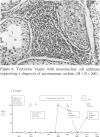Abstract
Genital tract reconstruction has been attempted in subfertile men with obstructive azoospermia (370 patients) or unilateral testicular obstruction (80 patients), and in vasectomised men undergoing reversal for the first (130 patients) or subsequent (32 patients) time. Histopathological changes in the obstructed testes and epididymes, and immunological responses to the sequestered spermatozoa have been studied to gain insight into possible causes of failure of surgical treatment. The results of surgery have been assessed by follow-up sperm counts and occurrence of pregnancies in the female partners. The best results were obtained with vasectomy reversal (patency 90%, pregnancy 45%), even after failed previous attempts (patency 87%, pregnancy 37%). Epididymovasostomy gave good results with postinfective caudal blocks (patency 52%, pregnancy 38%), while postinfective vasal blocks were better corrected by total anatomical reconstruction (patency 73%, pregnancy 27%) than by transvasovasostomy (patency 9%, no pregnancies). Poor results were obtained with capital blocks (patency 12%, pregnancy 3%), in which substantial lipid accumulation was demonstrated in the ductuli efferentes; three-quarters of these patients had sinusitis, bronchitis or bronchiectasis (Young's syndrome). There is circumstantial evidence to suggest that this syndrome may be a late complication of mercury intoxication in childhood. After successful reconstruction, fertility was relatively reduced in those men who had antibodies to spermatozoa, particularly amongst the postinfective cases. Similarly, impaired fertility was found in men with unilateral testicular obstruction and antibodies to spermatozoa. Mononuclear cell infiltration of seminiferous tubules and rete testis was noted occasionally, supporting a diagnosis of autoimmune orchitis; although rare, this was an important observation as the sperm output became normal with adjuvant prednisolone therapy.
Full text
PDF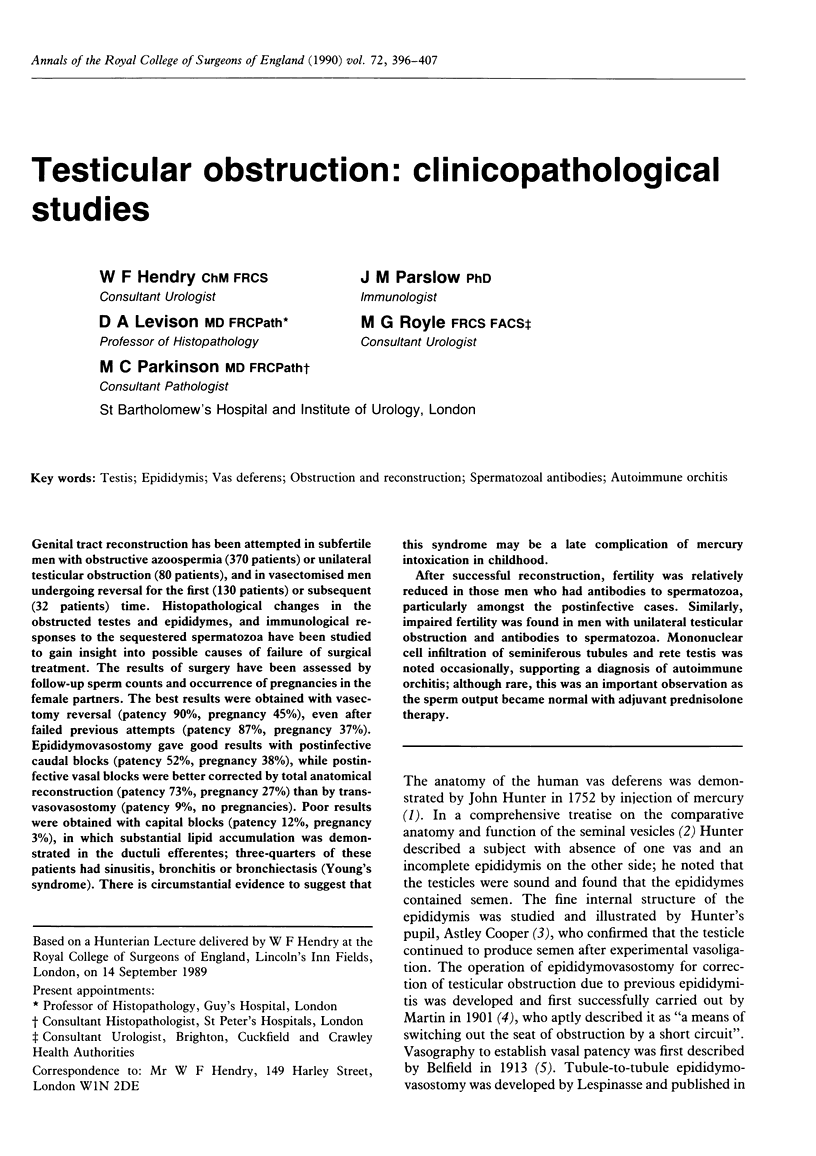
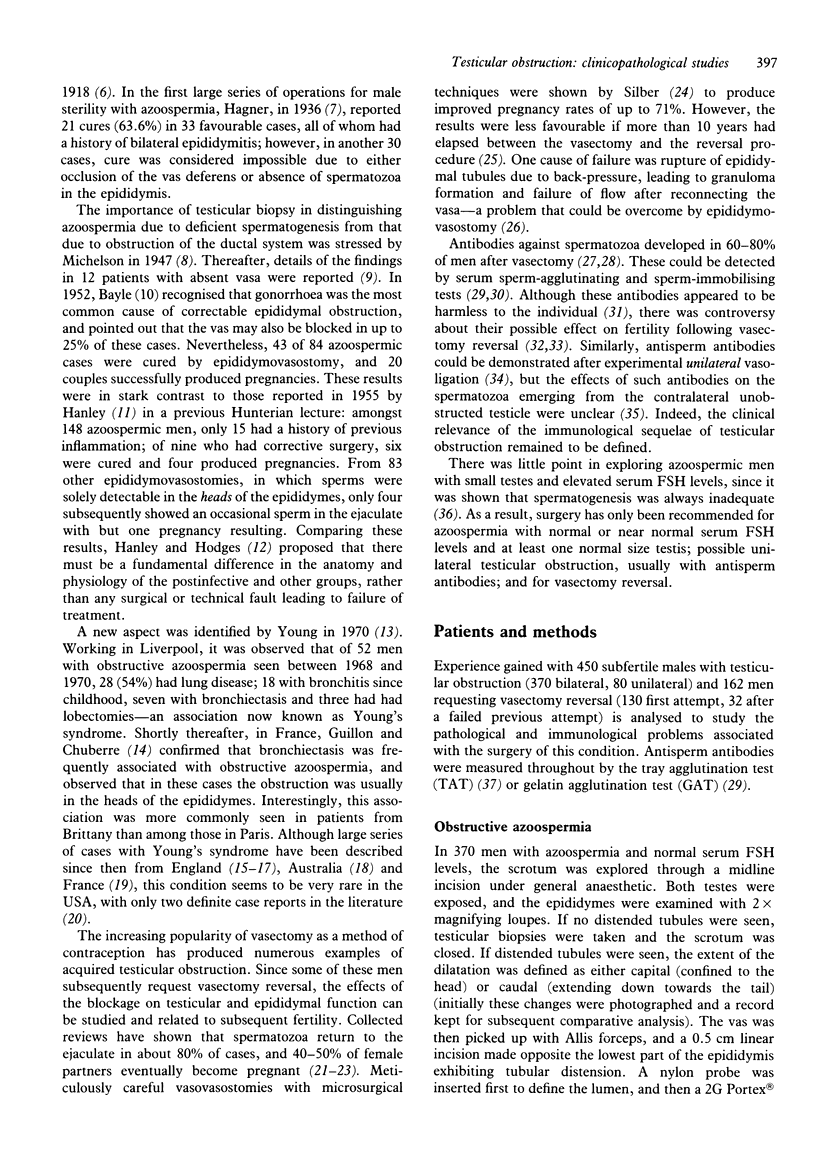
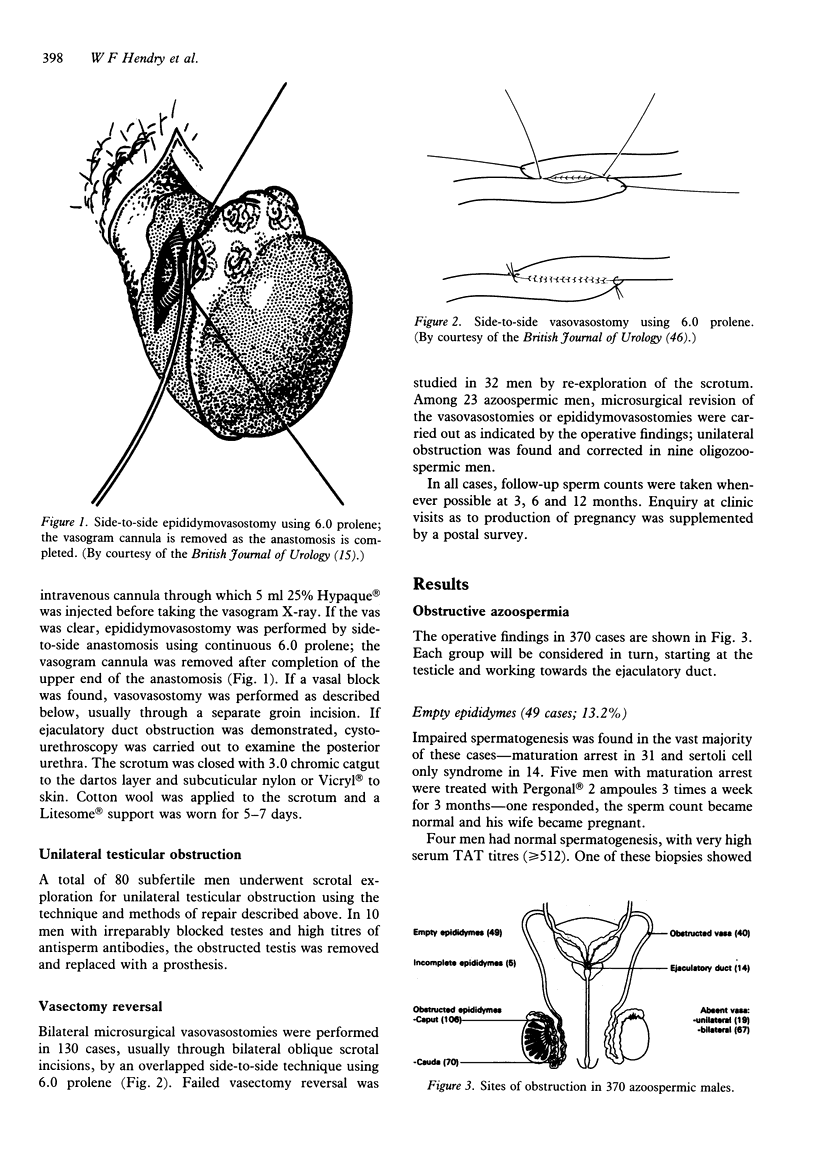
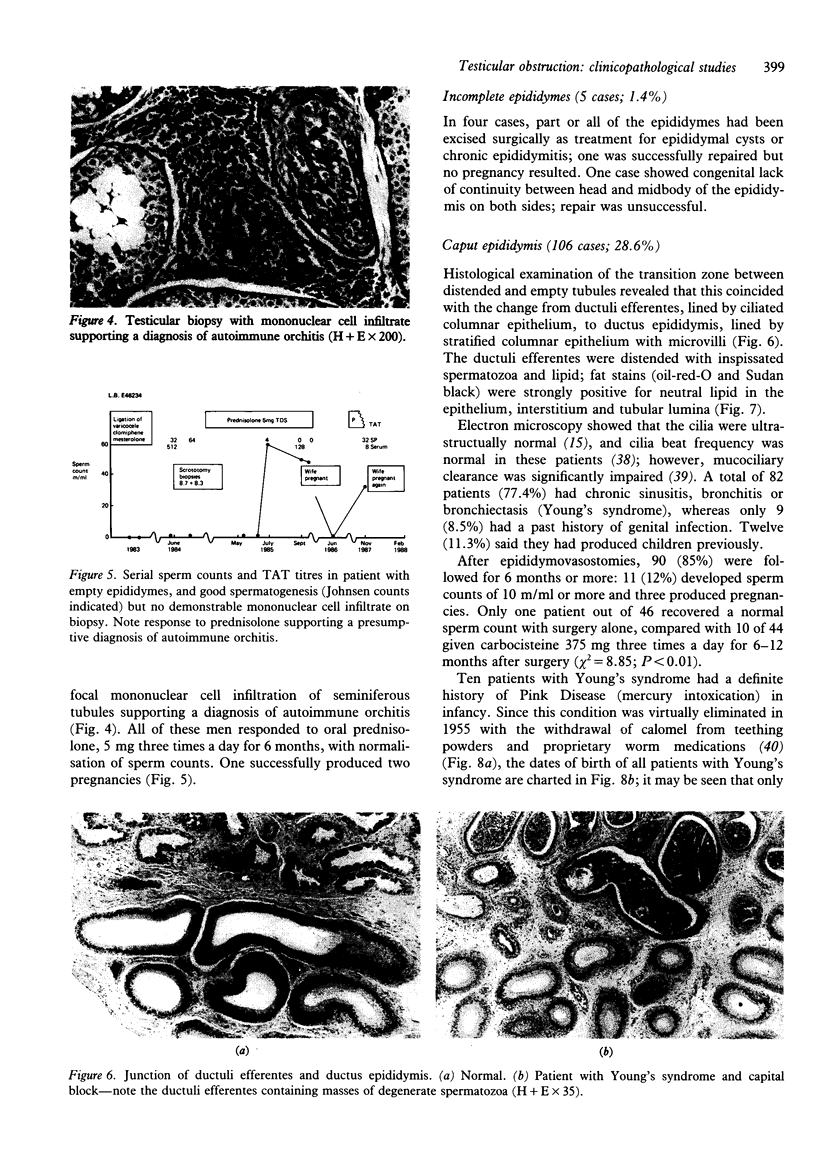
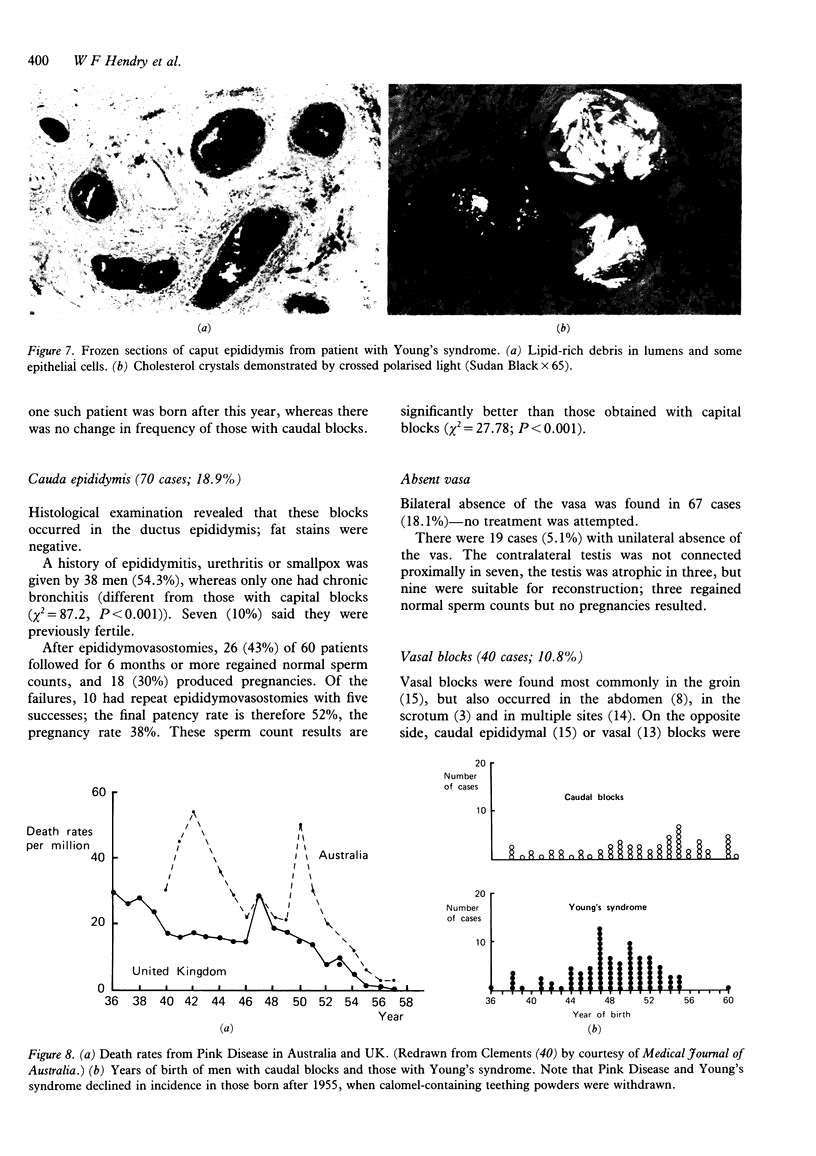
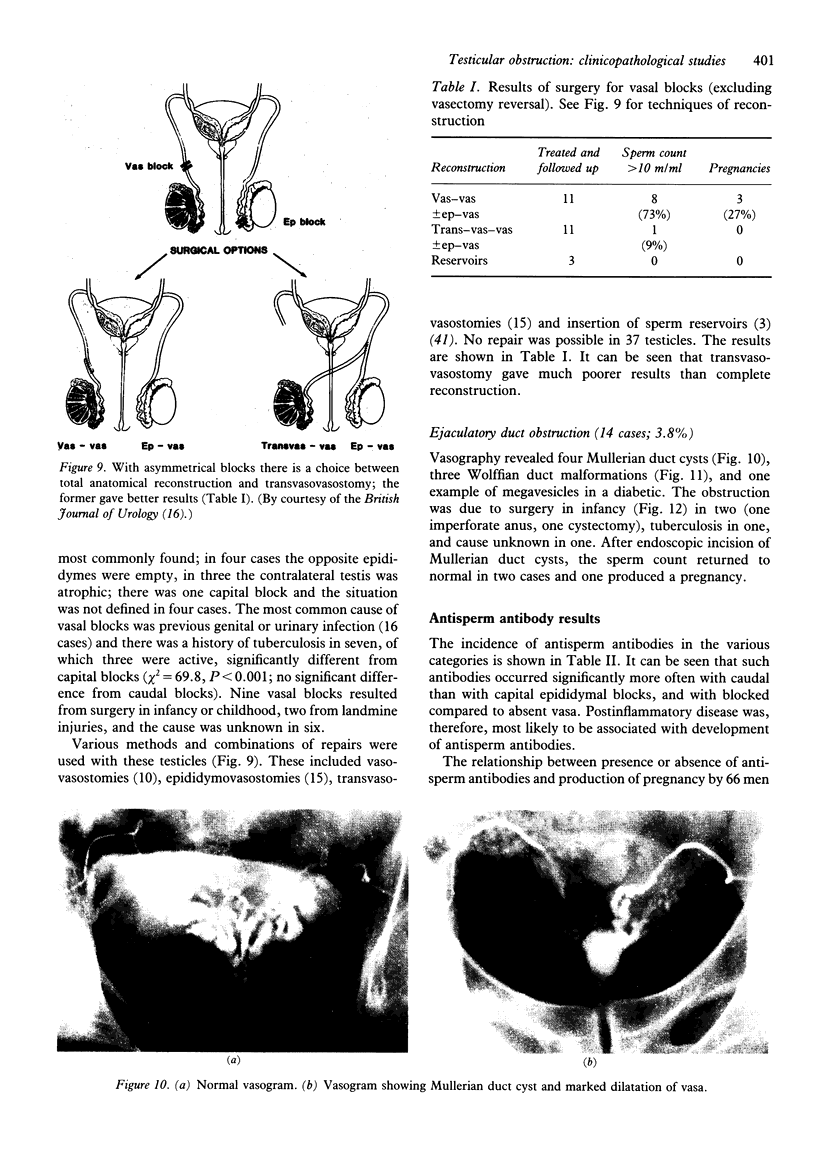
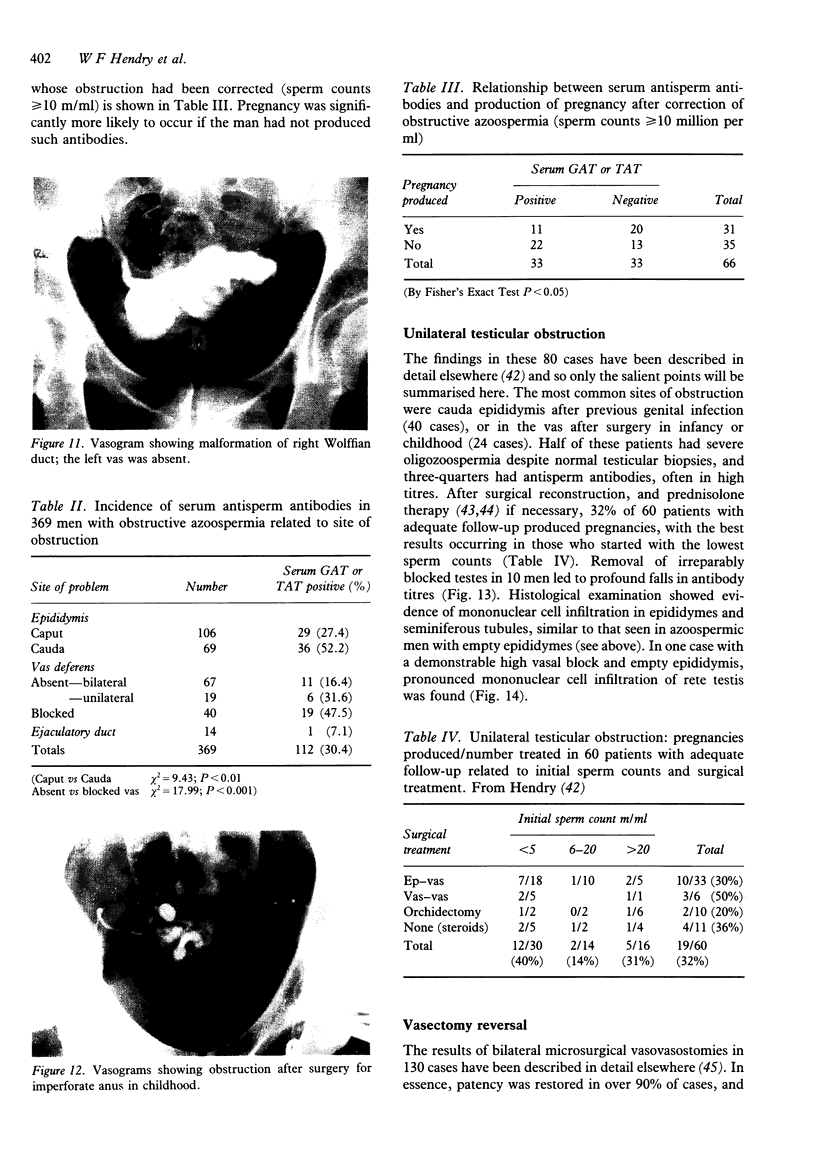
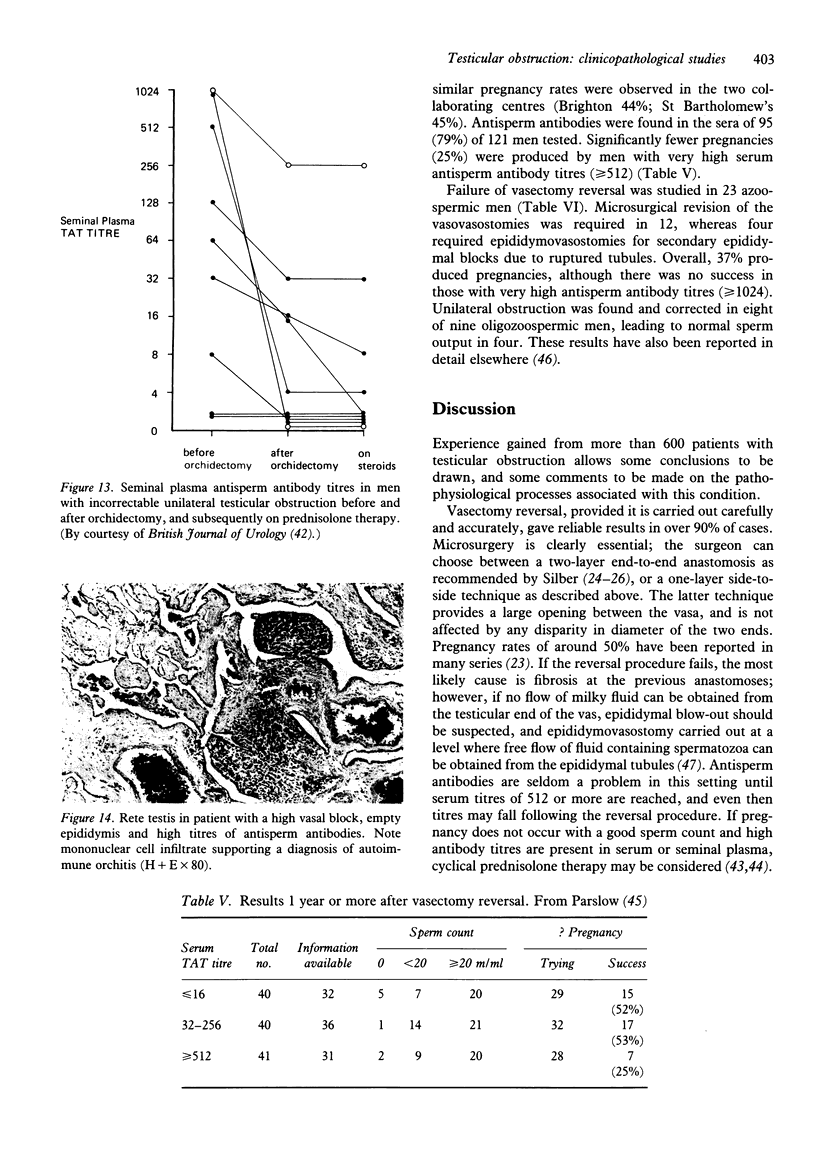
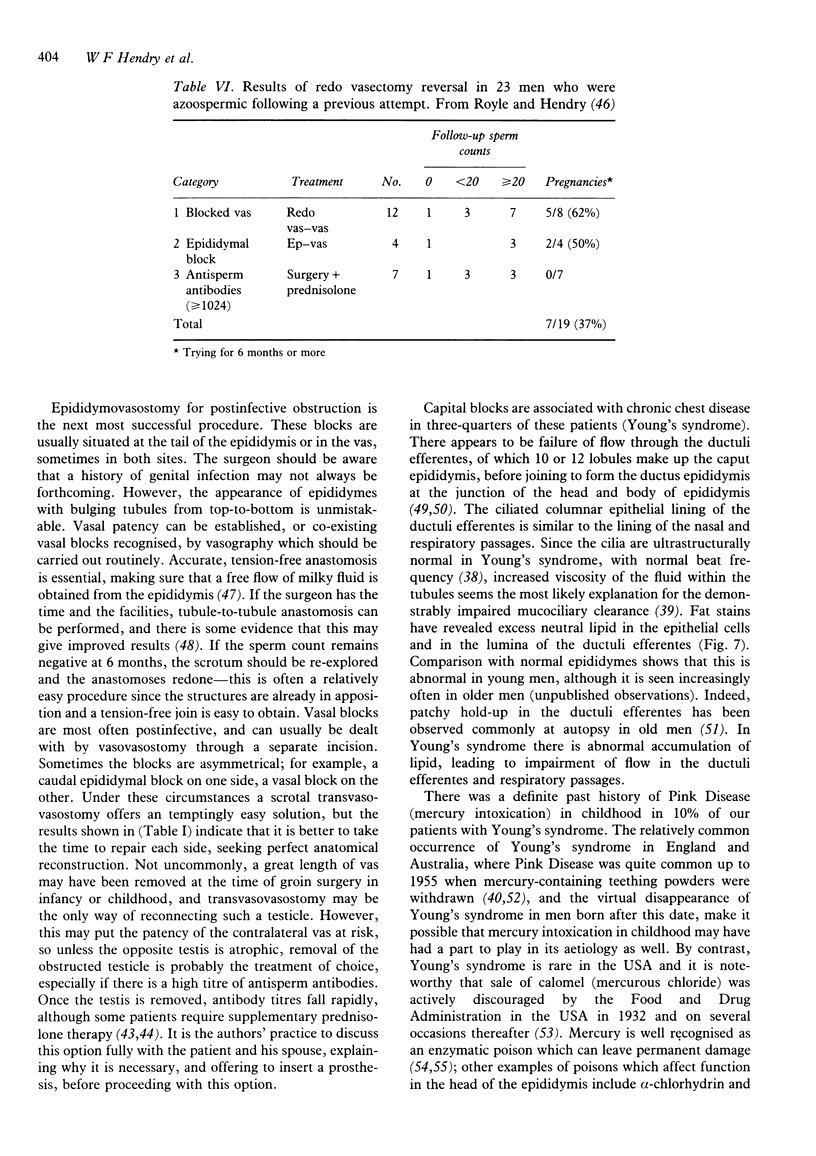
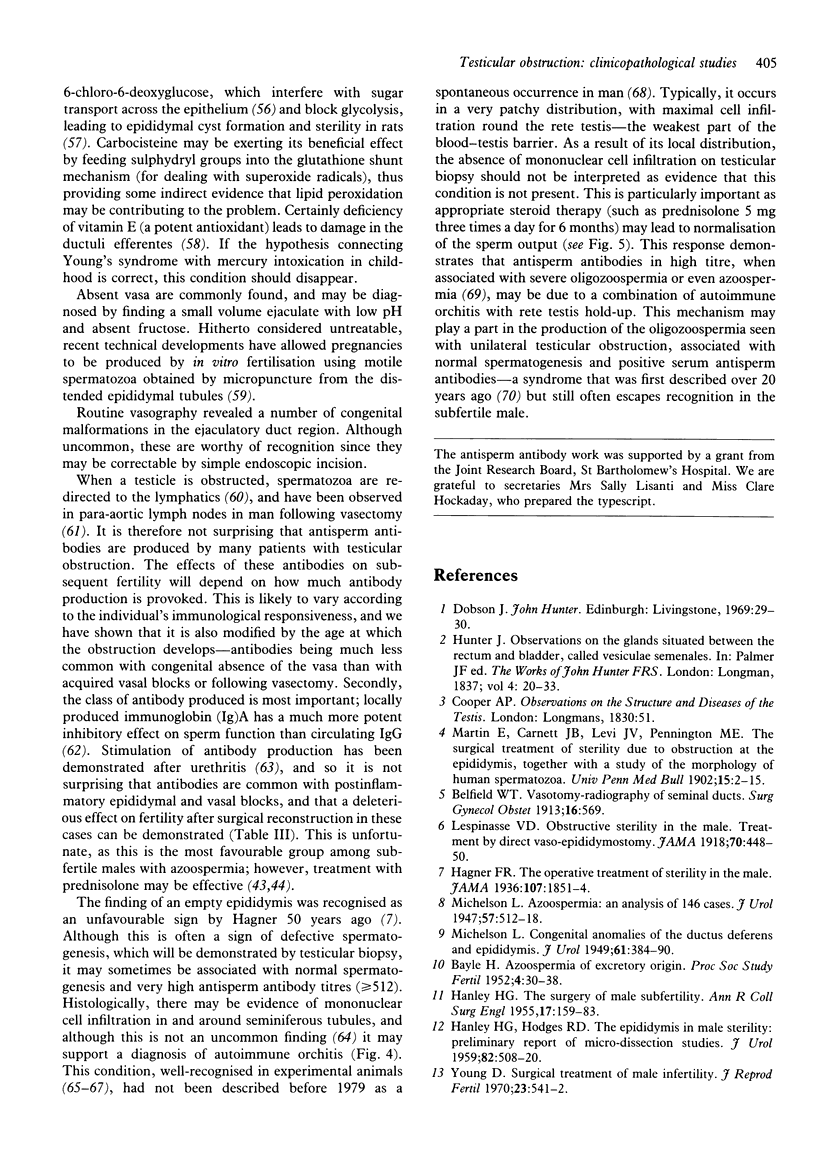
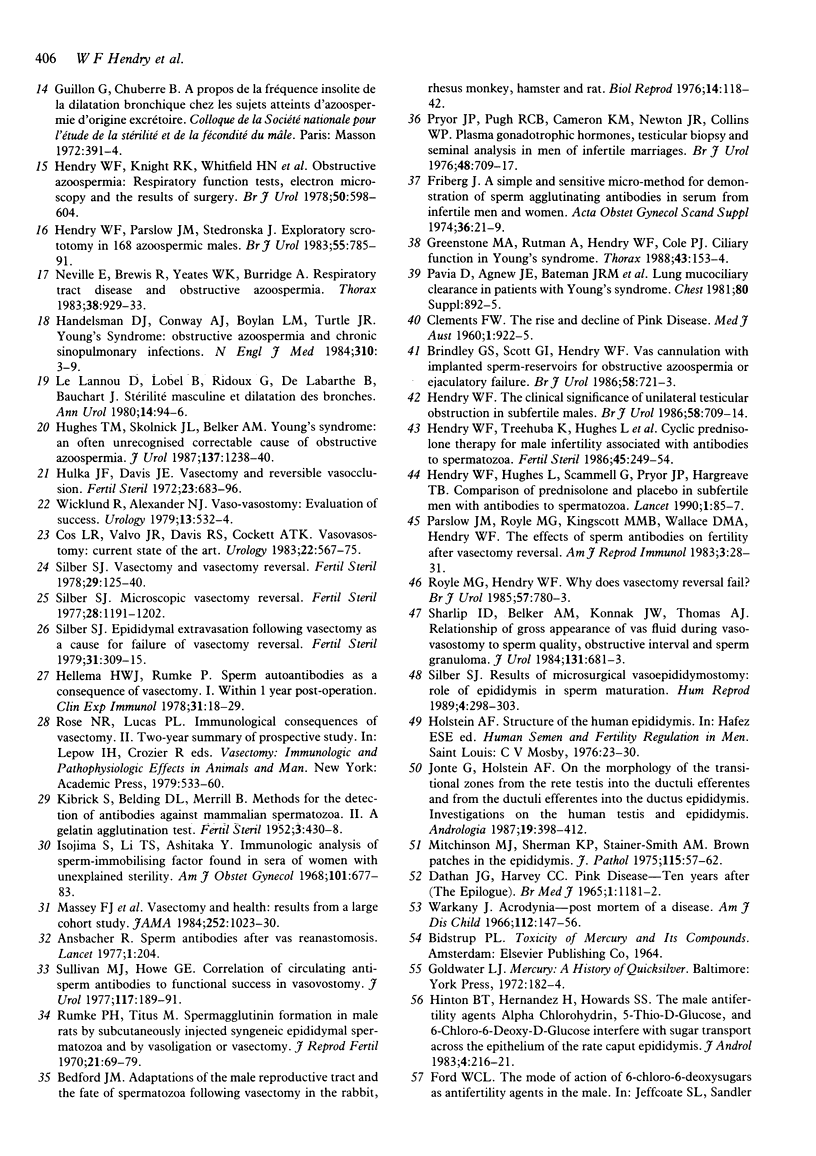
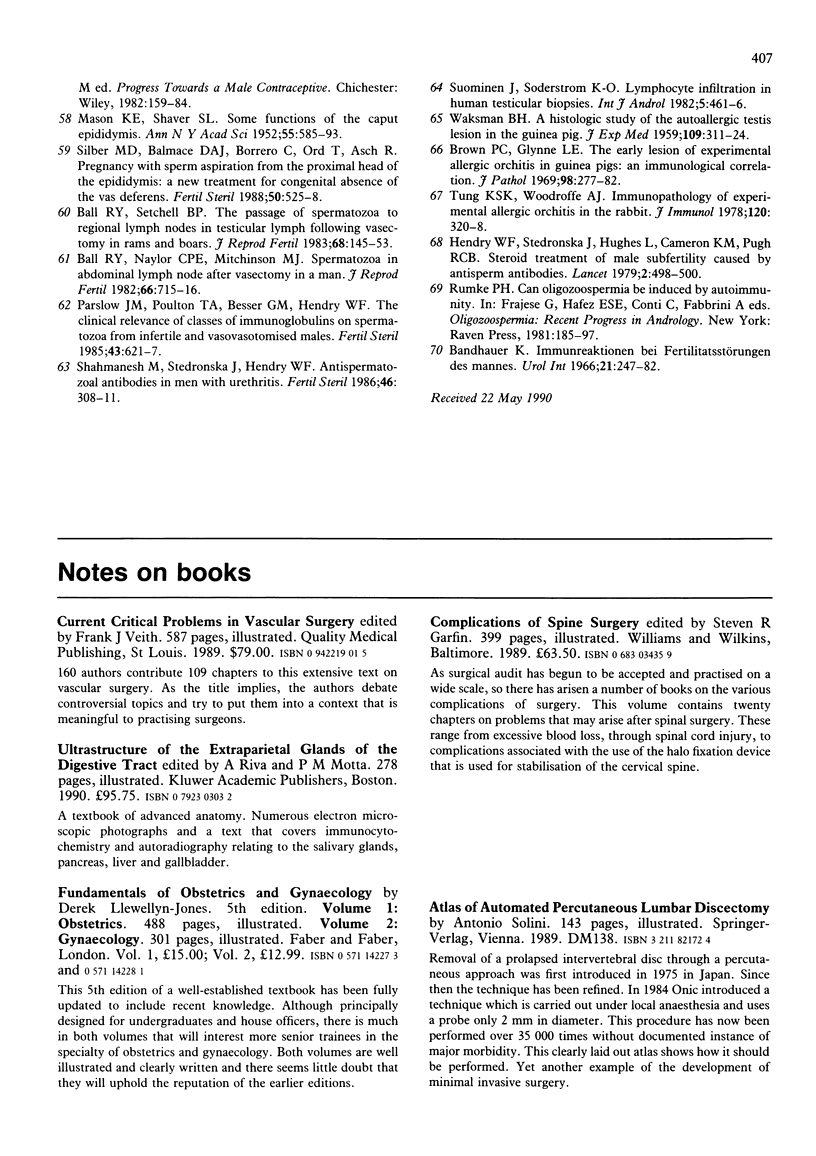
Images in this article
Selected References
These references are in PubMed. This may not be the complete list of references from this article.
- Ball R. Y., Naylor C. P., Mitchinson M. J. Spermatozoa in an abdominal lymph node after vasectomy in a man. J Reprod Fertil. 1982 Nov;66(2):715–716. doi: 10.1530/jrf.0.0660715. [DOI] [PubMed] [Google Scholar]
- Ball R. Y., Setchell B. P. The passage of spermatozoa to regional lymph nodes in testicular lymph following vasectomy in rams and boars. J Reprod Fertil. 1983 May;68(1):145–153. doi: 10.1530/jrf.0.0680145. [DOI] [PubMed] [Google Scholar]
- Bandhauer K. Immunreaktionen bei Fertilitätsstörungen des Mannes. Urol Int. 1966;21(3):247–282. doi: 10.1159/000279422. [DOI] [PubMed] [Google Scholar]
- Bedford J. M. Adaptations of the male reproductive tract and the fate of spermatozoa following vasectomy in the rabbit, rhesus monkey, hamster and rat. Biol Reprod. 1976 Mar;14(2):118–142. doi: 10.1095/biolreprod14.2.118. [DOI] [PubMed] [Google Scholar]
- Brindley G. S., Scott G. I., Hendry W. F. Vas cannulation with implanted sperm reservoirs for obstructive azoospermia or ejaculatory failure. Br J Urol. 1986 Dec;58(6):721–723. doi: 10.1111/j.1464-410x.1986.tb05920.x. [DOI] [PubMed] [Google Scholar]
- Brown P. C., Glynn L. E. The early lesion of experimental allergic orchitis in guinea pigs: an immunological correlation. J Pathol. 1969 Aug;98(4):277–282. doi: 10.1002/path.1710980407. [DOI] [PubMed] [Google Scholar]
- CLEMENTS F. W. The rise and decline of pink disease. Med J Aust. 1960 Jun 11;47(1):922–925. doi: 10.5694/j.1326-5377.1960.tb78443.x. [DOI] [PubMed] [Google Scholar]
- Cos L. R., Valvo J. R., Davis R. S., Cockett A. T. Vasovasostomy: current state of the art. Urology. 1983 Dec;22(6):567–575. doi: 10.1016/0090-4295(83)90297-2. [DOI] [PubMed] [Google Scholar]
- DATHAN J. G., HARVEY C. C. PINK DISEASE-TEN YEARS AFTER (THE EPILOGUE). Br Med J. 1965 May 1;1(5443):1181–1182. doi: 10.1136/bmj.1.5443.1181. [DOI] [PMC free article] [PubMed] [Google Scholar]
- Friberg J. A simple and sensitive micro-method for demonstration of sperm-agglutinating activity in serum from infertile men and women. Acta Obstet Gynecol Scand Suppl. 1974;36:21–29. doi: 10.3109/00016347409156399. [DOI] [PubMed] [Google Scholar]
- Greenstone M. A., Rutman A., Hendry W. F., Cole P. J. Ciliary function in Young's syndrome. Thorax. 1988 Feb;43(2):153–154. doi: 10.1136/thx.43.2.153. [DOI] [PMC free article] [PubMed] [Google Scholar]
- HANLEY H. G., HODGES R. D. The epididymis in male sterility: a preliminary report of microdissection studies. J Urol. 1959 Oct;82:508–520. doi: 10.1016/S0022-5347(17)65923-8. [DOI] [PubMed] [Google Scholar]
- HANLEY H. G. The surgery of male subfertility; Hunterian lecture delivered at the Royal College of Surgeons of England on 24th May 1955. Ann R Coll Surg Engl. 1955 Sep;17(3):159–183. [PMC free article] [PubMed] [Google Scholar]
- Handelsman D. J., Conway A. J., Boylan L. M., Turtle J. R. Young's syndrome. Obstructive azoospermia and chronic sinopulmonary infections. N Engl J Med. 1984 Jan 5;310(1):3–9. doi: 10.1056/NEJM198401053100102. [DOI] [PubMed] [Google Scholar]
- Hellema H. W., Rümke P. Sperm autoantibodies as a consequence of vasectomy. I. Within 1 year post-operation. Clin Exp Immunol. 1978 Jan;31(1):18–29. [PMC free article] [PubMed] [Google Scholar]
- Hendry W. F. Clinical significance of unilateral testicular obstruction in subfertile males. Br J Urol. 1986 Dec;58(6):709–714. doi: 10.1111/j.1464-410x.1986.tb05918.x. [DOI] [PubMed] [Google Scholar]
- Hendry W. F., Hughes L., Scammell G., Pryor J. P., Hargreave T. B. Comparison of prednisolone and placebo in subfertile men with antibodies to spermatozoa. Lancet. 1990 Jan 13;335(8681):85–88. doi: 10.1016/0140-6736(90)90548-j. [DOI] [PubMed] [Google Scholar]
- Hendry W. F., Knight R. K., Whitfield H. N., Stansfeld A. G., Pryse-Davies J., Ryder T. A., Pavia D., Bateman J. R., Clarke S. W. Obstructive azoospermia: respiratory function tests, electron microscopy and the results of surgery. Br J Urol. 1978 Dec;50(7):598–604. doi: 10.1111/j.1464-410x.1978.tb06221.x. [DOI] [PubMed] [Google Scholar]
- Hendry W. F., Parslow J. M., Stedronska J. Exploratory scrototomy in 168 azoospermic males. Br J Urol. 1983 Dec;55(6):785–791. doi: 10.1111/j.1464-410x.1983.tb03426.x. [DOI] [PubMed] [Google Scholar]
- Hendry W. F., Stedronska J., Hughes L., Cameron K. M., Pugh R. C. Steroid treatment of male subfertility caused by antisperm antibodies. Lancet. 1979 Sep 8;2(8141):498–501. doi: 10.1016/s0140-6736(79)91554-x. [DOI] [PubMed] [Google Scholar]
- Hendry W. F., Treehuba K., Hughes L., Stedronska J., Parslow J. M., Wass J. A., Besser G. M. Cyclic prednisolone therapy for male infertility associated with autoantibodies to spermatozoa. Fertil Steril. 1986 Feb;45(2):249–254. doi: 10.1016/s0015-0282(16)49163-6. [DOI] [PubMed] [Google Scholar]
- Hinton B. T., Hernandez H., Howards S. S. The male antifertility agents alpha chlorohydrin, 5-thio-D-glucose, and 6-chloro-6-deoxy-D-glucose interfere with sugar transport across the epithelium of the rat caput epididymidis. J Androl. 1983 May-Jun;4(3):216–221. doi: 10.1002/j.1939-4640.1983.tb00758.x. [DOI] [PubMed] [Google Scholar]
- Hughes T. M., 3rd, Skolnick J. L., Belker A. M. Young's syndrome: an often unrecognized correctable cause of obstructive azoospermia. J Urol. 1987 Jun;137(6):1238–1240. doi: 10.1016/s0022-5347(17)44467-3. [DOI] [PubMed] [Google Scholar]
- Hulka J. F., Davis J. E. Vasectomy and reversible vasocclusion. Fertil Steril. 1972 Sep;23(9):683–696. doi: 10.1016/s0015-0282(16)39198-1. [DOI] [PubMed] [Google Scholar]
- Jonté G., Holstein A. F. On the morphology of the transitional zones from the rete testis into the ductuli efferentes and from the ductuli efferentes into the ductus epididymidis. Investigations on the human testis and epididymis. Andrologia. 1987 May-Jun;19(3):398–412. doi: 10.1111/j.1439-0272.1987.tb02321.x. [DOI] [PubMed] [Google Scholar]
- KIBRICK S., BELDING D. L., MERRILL B. Methods for the detection of antibodies against mammalian spermatozoa. II. A gelatin agglutination test. Fertil Steril. 1952 Sep-Oct;3(5):430–438. doi: 10.1016/s0015-0282(16)31026-3. [DOI] [PubMed] [Google Scholar]
- MASON K. E., SHAVER S. L. Some functions of the caput epididymis. Ann N Y Acad Sci. 1952 Nov 20;55(4):585–593. doi: 10.1111/j.1749-6632.1952.tb26578.x. [DOI] [PubMed] [Google Scholar]
- MICHELSON L. Congenital anomalies of the ductus deferens and epididymis. J Urol. 1949 Feb;61(2):384–390. doi: 10.1016/S0022-5347(17)69078-5. [DOI] [PubMed] [Google Scholar]
- Martin E., Carnett J. B., Levi J. V., Pennington M. E. The surgical treatment of sterility due to obstruction at the epididymis; together with a study of the morphology of human spermatozoa. Univ Pa Med Bull. 1902 Mar;15(1):2–15. [PubMed] [Google Scholar]
- Massey F. J., Jr, Bernstein G. S., O'Fallon W. M., Schuman L. M., Coulson A. H., Crozier R., Mandel J. S., Benjamin R. B., Berendes H. W., Chang P. C. Vasectomy and health. Results from a large cohort study. JAMA. 1984 Aug 24;252(8):1023–1029. doi: 10.1001/jama.252.8.1023. [DOI] [PubMed] [Google Scholar]
- Mitchinson M. J., Sherman K. P., Stainer-Smith A. M. Brown patches in the epididymis. J Pathol. 1975 Jan;115(1):57–62. doi: 10.1002/path.1711150110. [DOI] [PubMed] [Google Scholar]
- Neville E., Brewis R., Yeates W. K., Burridge A. Respiratory tract disease and obstructive azoospermia. Thorax. 1983 Dec;38(12):929–933. doi: 10.1136/thx.38.12.929. [DOI] [PMC free article] [PubMed] [Google Scholar]
- Parslow J. M., Poulton T. A., Besser G. M., Hendry W. F. The clinical relevance of classes of immunoglobulins on spermatozoa from infertile and vasovasostomized males. Fertil Steril. 1985 Apr;43(4):621–627. doi: 10.1016/s0015-0282(16)48507-9. [DOI] [PubMed] [Google Scholar]
- Parslow J. M., Royle M. G., Kingscott M. M., Wallace D. M., Hendry W. F. The effects of sperm antibodies on fertility after vasectomy reversal. Am J Reprod Immunol. 1983 Jan-Feb;3(1):28–31. doi: 10.1111/j.1600-0897.1983.tb00208.x. [DOI] [PubMed] [Google Scholar]
- Pavia D., Agnew J. E., Bateman J. R., Sheahan N. F., Knight R. K., Hendry W. F., Clarke S. W. Lung mucociliary clearance in patients wit Young's syndrome. Chest. 1981 Dec;80(6 Suppl):892–895. doi: 10.1378/chest.80.6.892. [DOI] [PubMed] [Google Scholar]
- Pryor J. P., Pugh R. C., Cameron K. M., Newton J. R., Collins W. P. Plasma gonadotrophic hormones, testicular biopsy and seminal analysis in the men of infertile marriages. Br J Urol. 1976;48(7):709–717. doi: 10.1111/j.1464-410x.1976.tb06724.x. [DOI] [PubMed] [Google Scholar]
- Royle M. G., Hendry W. F. Why does vasectomy reversal fail? Br J Urol. 1985 Dec;57(6):780–783. doi: 10.1111/j.1464-410x.1985.tb07053.x. [DOI] [PubMed] [Google Scholar]
- Rümke P., Titus M. Spermagglutinin formation in male rats by subcutaneously injected syngeneic epididymal spermatozoa and by vasoligation or vasectomy. J Reprod Fertil. 1970 Feb;21(1):69–79. doi: 10.1530/jrf.0.0210069. [DOI] [PubMed] [Google Scholar]
- Shahmanesh M., Stedronska J., Hendry W. F. Antispermatozoal antibodies in men with urethritis. Fertil Steril. 1986 Aug;46(2):308–311. doi: 10.1016/s0015-0282(16)49530-0. [DOI] [PubMed] [Google Scholar]
- Sharlip I. D., Belker A. M., Konnak J. W., Thomas A. J., Jr Relationship of gross appearance of vas fluid during vasovasostomy to sperm quality, obstructive interval and sperm granuloma. J Urol. 1984 Apr;131(4):681–683. doi: 10.1016/s0022-5347(17)50578-9. [DOI] [PubMed] [Google Scholar]
- Silber S. J., Balmaceda J., Borrero C., Ord T., Asch R. Pregnancy with sperm aspiration from the proximal head of the epididymis: a new treatment for congenital absence of the vas deferens. Fertil Steril. 1988 Sep;50(3):525–528. doi: 10.1016/s0015-0282(16)60147-4. [DOI] [PubMed] [Google Scholar]
- Silber S. J. Epididymal extravasation following vasectomy as a cause for failure of vasectomy reversal. Fertil Steril. 1979 Mar;31(3):309–315. doi: 10.1016/s0015-0282(16)43880-x. [DOI] [PubMed] [Google Scholar]
- Silber S. J. Microscopic vasectomy reversal. Fertil Steril. 1977 Nov;28(11):1191–1202. [PubMed] [Google Scholar]
- Silber S. J. Results of microsurgical vasoepididymostomy: role of epididymis in sperm maturation. Hum Reprod. 1989 Apr;4(3):298–303. doi: 10.1093/oxfordjournals.humrep.a136892. [DOI] [PubMed] [Google Scholar]
- Silber S. J. Vasectomy and vasectomy reversal. Fertil Steril. 1978 Feb;29(2):125–140. doi: 10.1016/s0015-0282(16)43088-8. [DOI] [PubMed] [Google Scholar]
- Sullivan M. J., Howe G. E. Correlation of circulating antisperm antibodies to functional success in vasovasostomy. J Urol. 1977 Feb;117(2):189–191. doi: 10.1016/s0022-5347(17)58393-7. [DOI] [PubMed] [Google Scholar]
- Suominen J., Söderström K. O. Lymphocyte infiltration in human testicular biopsies. Int J Androl. 1982 Oct;5(5):461–466. doi: 10.1111/j.1365-2605.1982.tb00277.x. [DOI] [PubMed] [Google Scholar]
- Tung K. S., Woodroffe A. J. Immunopathology of experimental allergic orchitis in the rabbit. J Immunol. 1978 Jan;120(1):320–328. [PubMed] [Google Scholar]
- WAKSMAN B. H. A histologic study of the auto-allergic testis lesion in the guinea pig. J Exp Med. 1959 Mar 1;109(3):311–323. doi: 10.1084/jem.109.3.311. [DOI] [PMC free article] [PubMed] [Google Scholar]
- Warkany J. Acrodynia--postmortem of a disease. Am J Dis Child. 1966 Aug;112(2):147–156. [PubMed] [Google Scholar]
- Wicklund R., Alexander N. J. Vasovasostomy: evaluation of success. Urology. 1979 May;13(5):532–534. doi: 10.1016/0090-4295(79)90465-5. [DOI] [PubMed] [Google Scholar]
- Young D. Surgical treatment of male infertility. J Reprod Fertil. 1970 Dec;23(3):541–542. doi: 10.1530/jrf.0.0230541. [DOI] [PubMed] [Google Scholar]



